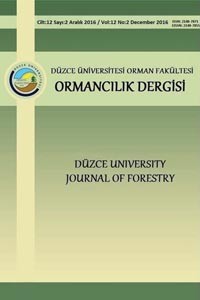Investigation of some Technological Properties of Composite Panels Manufactured with Melamine Urea Formaldehyde
Abstract
In this study, the technological properties of particleboard using melamine urea formaldehyde (MÜF) and urea formaldehyde (UF) adhesives and different hardener chemistries (aluminum sulphate, ammonium sulphate and ammonium chloride) were investigated. Continuous press is used for the production of panels. Physical properties; Moisture content, thickness increase and water uptake and mechanical properties; bending strength, modulus of elasticity and tensile strength were investigated according to the relevant standards. The results were compared according to different resin and hardener types.
As a result, all boards were found to meet the standards (TS-EN 312) produced at a density of 30 mm thickness and a target average of 633 kg / m³. It has been shown that using different hardeners in production board does not make a significant difference. However, it is suitable to use MÜF resin for damp environments. As the hardener, ammonium sulfate or ammonium chloride may be preferred.
Keywords
Particleboard Melamine urea formaldehyde Aluminum sulfate Ammonium sulfate Ammonium chloride
References
- Akbulut T. 1995. Factors Affecting Particleboard Production PH.D. Thesis Science Institute, Istanbul University 138 p.
- Anonim, 2016. http://www.ysmas.com.tr (Yıldız Sunta MDF fabrikası)
- Çolakoğlu G., Kalaycıoğlu H., Örs Y., 1993. Kızılçam Kabuklarının Yongalevha ve Kontrplak Üretiminde Değerlendirilmesi, Uluslararası Kızılçam Sempozyumu, Marmaris 18-23 Ekim, 700-710.
- Çolak S., Çolakoğlu G., Aydın İ. and Kalaycıoğlu H. 2007. Effect of Steaming Process on Some Properties of Eucalyptus Particleboard Bonded with UF and MUF Adhesives, Building and Environment 42 (1): 304-309.
Melamin ve Üre Formaldehit Tutkalı ile Üretilmiş Yonga Levhaların Bazı Teknolojik Özelliklerinin İncelenmesi
Abstract
References
- Akbulut T. 1995. Factors Affecting Particleboard Production PH.D. Thesis Science Institute, Istanbul University 138 p.
- Anonim, 2016. http://www.ysmas.com.tr (Yıldız Sunta MDF fabrikası)
- Çolakoğlu G., Kalaycıoğlu H., Örs Y., 1993. Kızılçam Kabuklarının Yongalevha ve Kontrplak Üretiminde Değerlendirilmesi, Uluslararası Kızılçam Sempozyumu, Marmaris 18-23 Ekim, 700-710.
- Çolak S., Çolakoğlu G., Aydın İ. and Kalaycıoğlu H. 2007. Effect of Steaming Process on Some Properties of Eucalyptus Particleboard Bonded with UF and MUF Adhesives, Building and Environment 42 (1): 304-309.
Details
| Journal Section | İç Anadolu’da Ağaçlandırma Çalışmaları |
|---|---|
| Authors | |
| Publication Date | December 15, 2016 |
| Published in Issue | Year 2016 Volume: 12 Issue: 2 |
........


